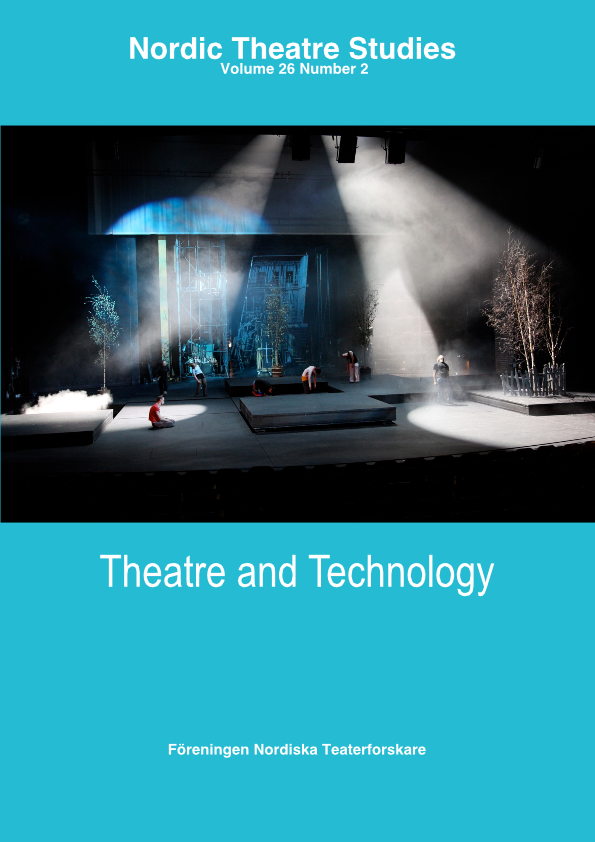Intermedial Ontologies: Strategies of Preparedness, Research and Design in Real Time Performance Capture
DOI:
https://doi.org/10.7146/nts.v26i2.24309Keywords:
Performance Capture, Motion Capture, The Omniscient Frame, avatar, intermediality, virtuality, performanceAbstract
The paper introduces and inspects core elements relative to the ‘live’ in performances that utilise real time Motion Capture (MoCap) systems and cognate/reactive virtual environments by drawing on interdisciplinary research conducted by Matthew Delbridge (University of Tasmania), and the collaborative live MoCap workshops carried out in projects DREX and VIMMA (2009-12 and 2013-14, University of Tampere). It also discusses strategies to revise manners of direction and performing, practical work processes, questions of production design and educational aspects peculiar to technological staging. Through the analysis of a series of performative experiments involving 3D real time virtual reality systems, projection mapping and reactive surfaces, new ways of interacting in/with performance have been identified. This poses a unique challenge to traditional approaches of learning about staging, dramaturgy, acting, dance and performance design in the academy, all of which are altered in a fundamental manner when real time virtual reality is introduced as a core element of the performative experience. Meanwhile, various analyses, descriptions and theorisations of technological performance have framed up-to-date policies on how to approach these questions more systematically. These have given rise to more sophisticated notions of preparedness of performing arts professionals, students and researchers to confront the potentials of new technologies and the forms of creativity and art they enable. The deployment of real time Motion Capture systems and co-present virtual environments in an educational setting comprise a peculiar but informative case of study for the above to be explored.References
Jean Baudrillard, Symbolic Exchange and Death, SAGE Publications, London, Thousand Oaks and New Delhi 1993.
Sarah Bay-Cheng, Chiel Kattenbelt, Andy Lavender and Robin Nelson, eds., Mapping Intermediality in Performance, Amsterdam University Press, Amsterdam 2010.
Susan Broadhurst and Josephine Machon, eds.,
Performance and Technology: Practices of Virtual Embodiment and Interactivity, Palgrave Macmillan, Kindle ebook edition, Basingstoke and New York 2011.
Dan Carreker, Game Developer’s Dictionary: A Multidisciplinary Lexicon for Professionals and Students, Course Technology / Cengage Learning, Boston 2012.
Freda Chapple and Chiel Kattenbelt, eds., Intermediality in Theatre and Performance, Rodopi, Amterdam and New York 2006.
Chapple and Kattenbelt, “Key Issues in Intermediality in Theatre and Performance” in Intermediality in Theatre and Performance 2006.
Edward Gordon Craig, “The Actor and the Ubermarionette” (1907) in Craig on The Theatre, J. Michael Walton, ed., Methuen, London 1983.
Matthew Delbridge and Joanne Tompkins, “Reproduction, mediation, and experience: virtual reality, motion capture and early modern theatre” in Space–Event–Agency–Experience, open access e-publication of the Drex Project, Centre for Practise as Research in Theatre, University of Tampere, Tampere 2012.
Matthew Delbridge, “The ecological approach to visual perception and the actor performance captured in the gaming landscape” in Animation Practice, Process & Production, vol. 2, issue 1-2, 2012.
Matthew Delbridge, Performance Capture: An Introduction, Palgrave Pivot 2015.
Peter Eckersall, Helen Grehan and Edward Sheer, “New Media Dramaturgy” in The Routledge Companion to Dramaturgy, Magda Romanska, ed., Routledge, London and New York 2015.
Gabriella Giannachi, “Environmental presence” in Archaeologies of Presence: Art, Performance and the Persistence of Being, Gabriella Giannachi, Nick Kaye and Michael Shanks, eds., Routledge, Abingdon and New York 2012.
Derek Hayes and Chris Webster, Acting and Performance for Animation, Focal Press, Burlington and Abingdon 2013.
Esa Kirkkopelto, “Näyttämön ilmiö” in Esitys katsoo meitä. Näyttämö & tutkimus 1, Pia Houni, Pentti Paavolainen, Heta Reitala and Hanna Suutela, eds., Teatterintutkimuksen seura ry, Helsinki 2005.
Rosemary Klich and Edward Scheer, Multimedia Performance, Palgrave Macmillan, Basingstoke and New York 2012.
Frank Nestor, “Performance Capture Is Acting” in Back Stage, vol. 52, no. 46, 2011.
Jennifer Parker-Starbuck, Cyborg Theatre: Corporeal/Technological Intersections in Multimedia Performance, Palgrave Macmillan, Basingstoke and New York 2011.
Sita Popat, “Keeping it Real: Encountering Mixed Reality in Igloo’s SwanQuake: House” in Convergence: The International Journal of Research into New Media Technologies, vol. 18, no. 1, 2012.
Riku Roihankorpi, “Performing Exteriority: An Essay on Virtuality and Mimesis in Spatial and Agential Contexts” in Space–Event–Agency–Experience, open access e-publication of the Drex Project, Centre for Practise as Research in Theatre, University of Tampere, Tampere 2012.
Chris Salter, Entangled: Technology and the Transformation of Performance, The MIT Press, Cambridge and London 2010.
Rob Shields, “Virtualities” in Theory, Culture & Society, no. 23, 2006.
Samuel Weber, Theatricality as Medium, Fordham University Press, New York 2004.
Robert Wechsler, “Artistic Considerations in the Use of Motion Tracking with Live Performers: A Practical Guide” in Performance and Technology, Susan Broadhurst and Josephine Machon, eds., Palgrave Macmillan, Kindle ebook edition, Basingstoke and New York 2011.
Downloads
Published
How to Cite
Issue
Section
License
The copyright belongs to the authors and Nordic Theatre Studies. Users can use, reuse and build upon the material published in the journal but only for non-commercial purposes. Users are allowed to link to the files, download the files, distribute the files on a local network (preferably by links), upload the files to local repositories if their institutions require them to do so, but not republish the files without proper agreements with the journal and the author.

